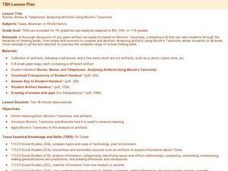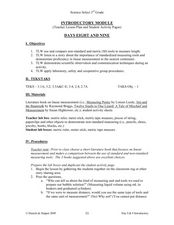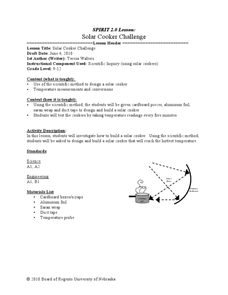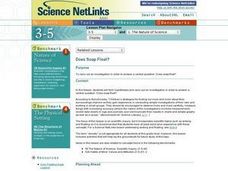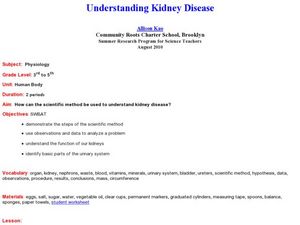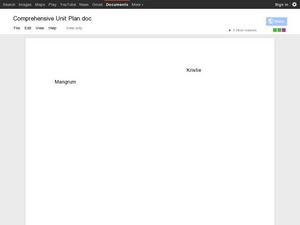Polar Trec
Ozone Data Comparison over the South Pole
Did you know the hole in the ozone is seasonal and filled by January every year? The lesson uses scientific measurements of the ozone over the South Pole to understand patterns. Scholars learn that the hole grew bigger annually before...
Curated OER
Science-Observation Skill Builders
Pupils explore observation while making connections between observation skills and careers (like how farmers observe the weather). They view a variety of nature photographs on the computer and practice their observation skills by...
Texas State Energy Conservation Office
Investigation: Conservation of Energy
By rolling marbles down a six-foot length of track, physical scientists determine how much energy is lost to heat. It is recommended that you opt for the foam pipe insulation track because more friction slows the marble, allowing...
American Chemical Society
Density: Sink and Float for Liquids
We don't think of liquids as floating typically, but a quick look at any oil spill tells a different story. Lesson explores various densities of liquids and why this fact is important. After observing the density variation, scholars...
Curated OER
Oat Seed Lab: A Model Scientific Experiment
Students investigate seed germination. In this lesson on scientific prediction, students conduct a scientific experiment using oat seeds.
Curated OER
Stones, Bones & Telephones: Analyzing Artifacts Using Bloom's Taxonomy
Seventh graders define metacognition, Bloom's Taxonomy, and artifacts. They, in groups, try to identify a mystery artifact using the Artifact Analysis sheet. They present their findings to the class.
Curated OER
Introductory Module
Third graders examine the non-standard method of measurement and compare it to the metric system of measurement. In this introductory module lesson, 3rd graders discover the scientific observation. Students also develop communication...
Curated OER
Graphing Toad/ Frog Respiration
Learners measure respiratory rates on live toads, and the effect water temperature has on their findings. In this scientific method lesson plan, students record their findings and present them in a graph, comparing the results.
Curated OER
Egg Fun
Students explore the physical properties of eggs. In this scientific observation instructional activity, students define characteristics of eggs, measure eggs vertically and horizontally, and use the scientific method to perform simple...
Curated OER
An Introduction to Chemistry
In this chemistry worksheet, learners solve 47 problems involving measurement conversions from one unit to another. They explain how values should be reported from measurements.
Curated OER
Symmetry in Paper Airplanes
Students explore symmetry. In this geometry and scientific inquiry lesson, students design paper airplanes with middle line symmetry, as well as right, obtuse, and acute angles. Students measure the plane's angles using a...
Curated OER
Solar Cooker Challenge
Young scholars use the scientific method to design a slow cooker. In this experimental method lesson plan students measure temperatures and conversions of the solar cooker that they create.
Curated OER
Does Soap Float?
Students form hypotheses and carry out an investigation in order to answer a central question: Does soap float? The focus of this lesson is on scientific inquiry, but it incorporates scientific topics such as sinking and floating.
Curated OER
Designing An Investigation
Students will design a scientific investigation. In this engineering design lesson, students will set up an investigation, collect data and form a conclusion about bridge design. They will use common household items to construct their...
Curated OER
Unit Conversion Problems
In this unit conversion activity, high schoolers solve 15 problems by using conversion factors to find their answers. They show all their work and express their answers in scientific notation with the proper number of significant figures.
Curated OER
An Introduction to Chemistry
In this introduction to chemistry worksheet, students complete 48 problem solving and fill in the blank questions. They convert measurements from one unit to another.
Curated OER
Adhesives: How Sticky is Your Tape?
Students test the adhesive strength of different tapes. In this adhesive lesson, students conduct an experiment to test the shear strength of the adhesives, take measurements, record data, and draw conclusions to explain each product's...
Curated OER
Understanding Kidney Disease
Students experiment to determine information about kidney function. In this kidney function activity, students use the scientific method to experiment with eggs, water, salt, sugar, and vegetable oil to simulate kidney function. They...
Curated OER
The Life Cycle of the Mealworm
Fourth graders provide a habitat for live mealworms and observe their life cycle. In this animal life cycle and scientific inquiry activity, 4th graders create a habitat for a live mealworm and observe and record related data as it...
Curated OER
Look at those Leaves!
Students observe leaves for patterns and similarities. In this science activity, students sort through a pile of leaves to find patterns and take measurements. Students make leaf rubbings to view the details of the leaves.
Curated OER
Death On Board La Belle: Finding Clues from Old Bones
Learners practice analyzing skeletal remains for clues by using the Internet. In this scientific investigation lesson plan, students research the La Belle shipwreck using the Internet and written materials, later completing a...
Curated OER
Diffusion
Students design and carry out an experiment according to the scientific method. The experiment must test the effects of time and concentration on the rate of diffusion of potassium permanganate into potato cubes. After performing the...
Curated OER
The Earth around Us: Air, Water & Soil
Students recognize that science is everywhere. In this scientific method lesson plan, students experiment with height and record their experiment using the scientific method. Students must identify each step of the...
Curated OER
Working with Questions
Students explore questions in a scientific context. They consider what makes questions testable. After reading short scenarios, students come up with their own testable questions about the reading.





